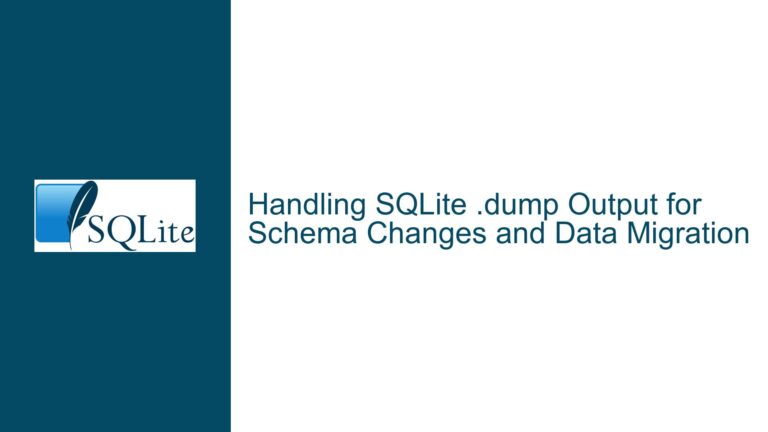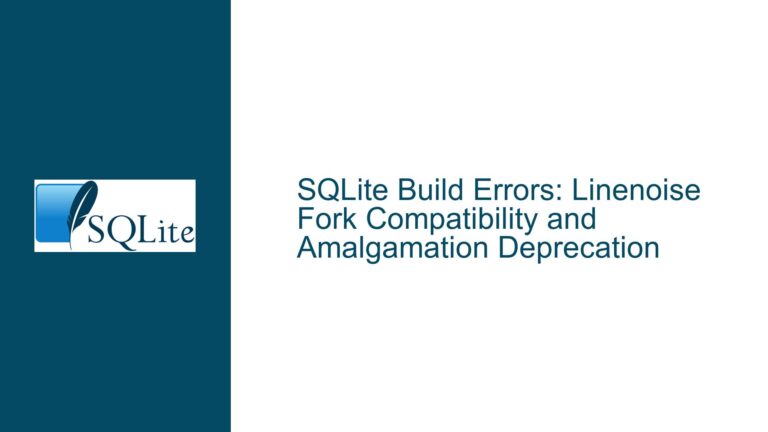Exporting Oracle Tables to SQLite: Challenges and Solutions
Issue Overview: Exporting Oracle Tables to SQLite via CSV and ODBC Gateways
Exporting data from Oracle to SQLite is a common task for developers who need to migrate or replicate data between these two database systems. Oracle, being a robust and feature-rich enterprise-grade database, often serves as the source of truth for large-scale applications. SQLite, on the other hand, is a lightweight, serverless database engine that is ideal for embedded systems, mobile applications, and scenarios where simplicity and portability are paramount. The process of exporting Oracle tables to SQLite involves several steps, including schema conversion, data extraction, and data loading. Two primary methods are often employed for this task: using CSV files as an intermediary format and leveraging ODBC gateways.
The CSV method involves exporting Oracle tables into CSV files and then importing these files into SQLite. This approach is straightforward and leverages SQLite’s ability to import CSV data directly. However, it requires careful handling of data types, especially when dealing with Oracle-specific data types that may not have direct equivalents in SQLite. Additionally, the CSV method may involve the use of FIFO (First In, First Out) pipes to stream data between the two systems, which can introduce complexities related to data buffering and synchronization.
The ODBC gateway method, on the other hand, involves using an ODBC driver to connect SQLite to Oracle directly. This method can be more efficient than the CSV approach, as it allows for direct data transfer without the need for intermediate files. However, ODBC gateways can be more brittle and prone to configuration issues, especially when dealing with different versions of ODBC drivers, Oracle clients, and SQLite. The dg4odbc gateway, which is a specific implementation of the ODBC gateway for Oracle, has been reported to be particularly problematic in some cases, leading to instability and data transfer failures.
Both methods have their strengths and weaknesses, and the choice between them often depends on the specific requirements of the project, such as the volume of data, the complexity of the schema, and the need for real-time data synchronization. In the following sections, we will explore the possible causes of issues that may arise during the export process and provide detailed troubleshooting steps and solutions to address these challenges.
Possible Causes: Data Type Mismatches, ODBC Configuration Issues, and FIFO Synchronization Problems
When exporting Oracle tables to SQLite, several issues can arise that may hinder the process. These issues can be broadly categorized into three main areas: data type mismatches, ODBC configuration issues, and FIFO synchronization problems.
Data Type Mismatches: Oracle and SQLite have different data type systems, and not all Oracle data types have direct equivalents in SQLite. For example, Oracle supports advanced data types such as TIMESTAMP WITH TIME ZONE, INTERVAL, and CLOB, which do not have direct counterparts in SQLite. When exporting data from Oracle to SQLite, these data type mismatches can lead to data loss or corruption if not handled properly. Additionally, SQLite’s dynamic typing system, which allows for flexible data storage, can sometimes lead to unexpected behavior when importing data from a strongly-typed system like Oracle.
ODBC Configuration Issues: The ODBC gateway method relies on the proper configuration of the ODBC driver, Oracle client, and SQLite. Any misconfiguration in these components can lead to connection failures, data transfer errors, or performance issues. For example, the dg4odbc gateway requires specific settings in the ODBC configuration files, and any deviation from these settings can result in instability. Additionally, differences in the versions of the ODBC driver, Oracle client, and SQLite can introduce compatibility issues that may not be immediately apparent.
FIFO Synchronization Problems: The CSV method often involves the use of FIFO pipes to stream data between Oracle and SQLite. FIFO pipes are a form of inter-process communication that allows data to be passed between processes in a first-in, first-out manner. However, FIFO pipes can introduce synchronization issues, especially when dealing with large volumes of data or when the data transfer rate between the two systems is not balanced. For example, if the Oracle process writes data to the FIFO pipe faster than the SQLite process can read it, the pipe may become full, leading to data loss or blocking. Conversely, if the SQLite process reads data from the FIFO pipe faster than the Oracle process can write it, the pipe may become empty, leading to underflow conditions.
In the next section, we will delve into the troubleshooting steps and solutions to address these issues, ensuring a smooth and reliable export process from Oracle to SQLite.
Troubleshooting Steps, Solutions & Fixes: Handling Data Type Mismatches, Configuring ODBC Gateways, and Managing FIFO Synchronization
Handling Data Type Mismatches: To address data type mismatches between Oracle and SQLite, it is essential to perform a thorough analysis of the Oracle schema and map each Oracle data type to an appropriate SQLite data type. For example, Oracle’s TIMESTAMP WITH TIME ZONE can be mapped to SQLite’s TEXT type, with the time zone information stored as part of the string. Similarly, Oracle’s CLOB type can be mapped to SQLite’s TEXT type, with the understanding that SQLite’s TEXT type has a maximum size limit of 1 GB.
In cases where direct mapping is not possible, it may be necessary to transform the data during the export process. For example, Oracle’s INTERVAL data type can be converted to a numeric value representing the number of seconds, which can then be stored in SQLite’s INTEGER or REAL type. Additionally, it is important to validate the data after the export to ensure that no data loss or corruption has occurred. This can be done by comparing the row counts and checksums of the data in Oracle and SQLite.
Configuring ODBC Gateways: To ensure a stable and reliable ODBC gateway connection between Oracle and SQLite, it is crucial to properly configure the ODBC driver, Oracle client, and SQLite. This includes setting the correct connection parameters in the ODBC configuration files, such as the DSN (Data Source Name), username, password, and connection string. Additionally, it is important to ensure that the versions of the ODBC driver, Oracle client, and SQLite are compatible with each other.
For the dg4odbc gateway, specific attention should be paid to the settings in the odbc.ini and odbcinst.ini files. These files should be configured to match the requirements of the dg4odbc gateway, including the correct driver name, library path, and connection parameters. It is also recommended to test the ODBC connection using a tool like isql or odbcad32 to verify that the connection is working correctly before attempting to transfer data.
Managing FIFO Synchronization: To avoid synchronization issues when using FIFO pipes for data transfer, it is important to carefully manage the data flow between Oracle and SQLite. This can be achieved by implementing flow control mechanisms that balance the data transfer rate between the two systems. For example, the Oracle process can be configured to write data to the FIFO pipe in smaller chunks, allowing the SQLite process to keep up with the data flow. Additionally, the SQLite process can be configured to read data from the FIFO pipe in a non-blocking manner, ensuring that it does not stall if the pipe becomes empty.
Another approach to managing FIFO synchronization is to use buffering. This involves writing data from Oracle to a buffer, which is then read by the SQLite process. The buffer can be implemented as a memory-mapped file or a temporary file, depending on the size of the data and the available system resources. By using buffering, the data transfer process can be decoupled from the FIFO pipe, reducing the risk of synchronization issues.
In conclusion, exporting Oracle tables to SQLite can be a complex process that requires careful consideration of data type mismatches, ODBC configuration, and FIFO synchronization. By following the troubleshooting steps and solutions outlined in this guide, developers can ensure a smooth and reliable data transfer between these two database systems. Whether using the CSV method or the ODBC gateway method, it is important to validate the data after the export and to test the configuration thoroughly to avoid any potential issues. With the right approach, exporting Oracle tables to SQLite can be a straightforward and efficient process that meets the needs of even the most demanding applications.





